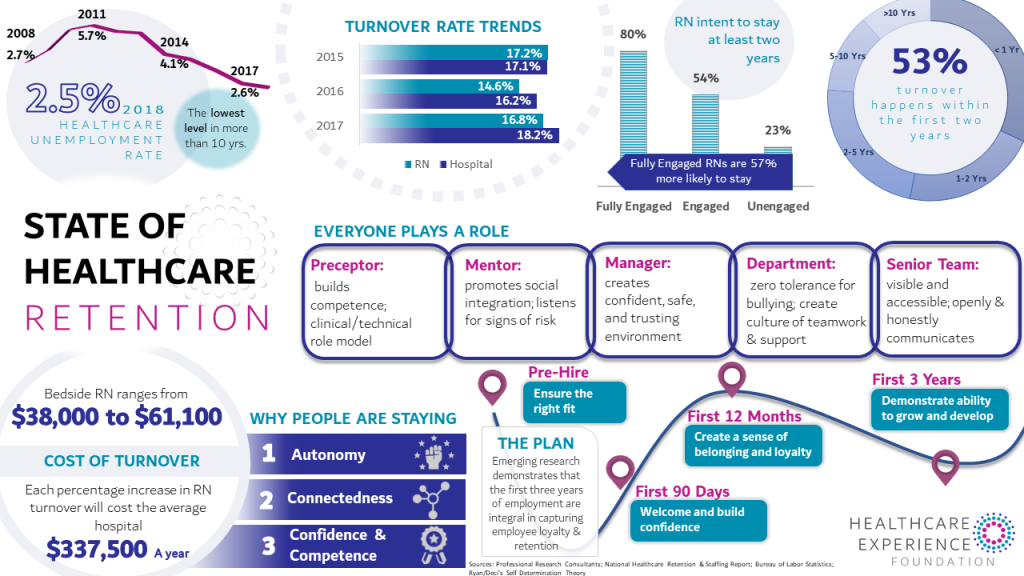Retention: Is our effort equaling the best possible results?
At the heart of many healthcare organizations’ mission statements is imperative to place the patient at the center of our work. Either directly or indirectly stated, the quality of the patient experience (both clinical quality and patient’s perceptions of care and service) is paramount to why many organizations exist. As such, our ability to attract and retain high performing employees who can deliver a consistently excellent experience remains both a priority and challenge for hospitals and health care systems. Some key questions we ask organizations looking to both improve employee retention, decrease turnover and improve service and quality are:
- Are your systems of accountability set up to support retention?
- Are your leaders equipped with development and learning programs to support hiring and retaining the best?
- Do you have standard leader expectations for selection, orientation, and retention?
- Why should a candidate choose your organization over a local competitor or a traveling assignment?
- Are we keeping the right employees?

Reflection on these questions is important. Research shows that 51% of disengaged nurses have no plan to leave your organization1. While most would agree it is critical to select individuals that reflect the organization’s commitment to patient-centered excellence, all too often the selection is rushed to fill vacancies and we delay dealing with employees who are a detriment to our organization and the patients/families we serve. Anyone who has ever made a bad hire knows that the impact can be damaging on so many levels. We have looked across organizations for the key themes that can equip leaders to improve engagement, decrease disengagement and improve retention of high performers.
While it is important to understand your organization’s unique proposition of excellence for your workforce, our coaching team recommends honing the following five practices. While each is likely intuitive, they are not always easy:

- Hire the right fit. You must select the right players. Selection should be rigorous, so each employee can be engaged and empowered to make a difference (and ultimately be set up for success in the organization). Your selection process determines the candidates and, ultimately, hires that will be entrusted to care for your patients and internal departments served. The goal should be to narrow your organizational “front door” so that only those who embody your values and commitment to excellence can walkthrough. Some guidelines for success include:
- Clear expectations- being open, transparent and realistic about what the job entails is important. Involving candidates in pre-hire shadowing/simulation can make certain there is the best fit.
- Involve peers- practices such as peer interviewing (where high performers are involved in the selection process) can create a sense of team and camaraderie. When peers are involved in hiring decisions, they are more invested in the success of new hires, can provide input that may help a manager in making selection decisions, and serve as an early support system for new employees.
- Know what the ideal candidate looks like. Take time to outline the ideal hire in terms of clinical, technical and values attributes. This will allow you to “vision” the type of employee that you want to welcome to your team. It will help set expectations of anyone else involved in interviews and give you a filter to best evaluate candidates. Knowing what excellent should look like can help you structure behavioral-based interview questions and add rigor to selection practices. Importantly, you will be less likely to “settle” for someone who does not shine.
- Follow up after hire- did our promise/expectations match your reality. Often, we hire a new employee and ask them for the “fresh perspective” and fail to follow up. Embracing the perspective of new employees helps us demonstrate their input matters, we care about their feedback, and helps us evolve and innovate.
- Establish Accountability. Dealing with poor performers is the number one barrier our team hears as an obstacle to improving results. Empowering each leader with Retention and Turnover goals is a way to “cascade” accountability and spread ownership for hiring and retaining the best employees. We also must as leaders share accountability with our employees. Employees must know their performance strengths and gaps. Here are two forms of accountability that are both essential:
- Clinical and technical- Can employees safely and effectively do the job hired to do? If yes, ensure your employee knows and understand how much you value their contributions to the team. If the answer is inconsistent, it is important to validate proficiency and coach to developmental opportunities. If no, you must make important decisions if this individual can continue to be a part of the organization and/or needs to transition to a more appropriate role.
- Values and standards- Do employees live the values of your organization? Values and Standards of Behavior are Always (or non-negotiable) expectations of all leaders, staff, physicians, and providers. Many of our clients ask applicants to sign standards/values during the application process, review during new hire orientation, reinforce values regularly and include them in annual performance reviews.
- Fulfill Your Role as a Coach. One of the most important traits of leaders (voted by employees) is Leading by Example2. As leaders, sometimes it can be all too easy to postpone accountability, fail to coach to a performance gap, or hope an issue will resolve by itself. Coaching employees is critical. We cannot be too rushed and hurried.
- Be willing to be vulnerable. Leadership vulnerability can be a powerful tool to create a sense of psychological safety among your team. The vulnerability can create an open forum for employees to have a strong, loyal relationship with you and your organization. Asking questions like: What is one thing I currently do that you would like for me to continue to do? What is one thing you would like me to more often? What can I do to help you be more effective?
- Remember the “why”. In our hurry to get work done, we can fail to explain why. Reconnecting employees to the why and the reason can grow to buy in and support for change.
- Have the conversation. Conflict can be challenging for even the most seasoned leaders. Our Healthcare Experience Foundation team developed a framework for conflict management coaching called the Conversation Curve
- Engage your high achievers. Your high achievers can serve as catalysts to retain new employees, as well as serve as champions for service, quality and performance initiatives.
- Put excellence on a pedestal. too often we assume our high achievers know how much we appreciate them, or we hesitate to recognize them because we may not have imminent ways to “reward” them (e.g., no clear way to incentive with raise, promotion). Gratitude and personal recognition can truly transform our relationships with high achievers. It is important for leaders to reflect on performance evaluations… Do your high achievers and low achievers have similar evaluation scores? If so, change that.
- Seek their input. Involve your stars in strategies to retain and recognize the team. They have ideas, energy, and a drive to make the organization successful. Invite their participation. Ask them about strengths and vulnerabilities with selecting, retaining the best employees. Make it safe for them to give you direct feedback.
There are endless reasons to make Retention a priority in your organization. In this churning and evolving healthcare environment, leaders are more challenged than ever before. We’re responsible for more lives at a time when the healthcare industry faces soaring costs, falling reimbursement rates, rigorous standards of quality, workforce shortages, more informed patients, and new expectations for service excellence. Reducing turnover and elevating high performer retention is not a matter of luck, it is the intersection of process, expectations, and engagement.
- 2019. King, C., Bradley, L.A., PRC National Nursing Study
- Opinion Research Corporation



